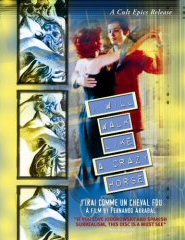
(a.k.a. J'IRAI COMME UN CHEVAL FOU)
Fernando Arrabal began his career as a playwright almost 50 years ago, and is credited as a co-founder of Spain's Panic Movement - a group of artistes who set out to challenge bourgeois morals and hypocrisies.
His play FANDO AND LIS was interpreted for the screen by Alejandro Jodorowsky (EL TOPO; SANTA SANGRE), which led to a riot at its premiere. However, Arrabal didn't make his mark as a filmmaker until 1971, with his infamous feature debut VIVA LA MUERTE.
MUERTE, also available now from Cult Epics, was semi-autobiographical for Arrabal (based on his own novel), recounting the tale of a young boy who witnessed the arrest of his father at the end of the Civil War, on charges of treason.
The film was full of shocking surreal images, such as the mother squatting to defecate on the father's head, and a climactic scene of performance art that remains one of the most extreme images contained within a non-mondo movie to date.
Arrabal had arrived on the movie scene in a storm of controversy. Three years later, he shocked and offended even further with his follow-up, I WILL WALK LIKE A CRAZY HORSE.
It tells the tale of Aden (George Shannon, SUGAR COOKIES), a young man who flees his wealthy Paris home when his mother dies in mysterious circumstances. He makes his way to an unnamed desert, where he meets the midget hermit Marvel (Hachemi Marzouk). Marvel has lived his whole life in the desert with the animals and is oblivious to "civilised" society - to the point where he has become at one with nature: when Marvel speaks to his animals, they appear to understand him; when he desires, the night changes to day and vice versa.
For a time Aden and Marvel live happily, developing a strong friendship together and dancing merrily in the dunes, blissfully unaware of the French police's hunt for Aden in the city.
Things start turning sour when Aden arranges to take Marvel to Paris to share his wealth with him, and subject him to the luxuries that money (an unknown commodity to the dwarf) can buy - women, fine food, opulent apartments etc.
Marvel is initially perplexed by this new world - when Aden hands him an umbrella, he fills it with rain then drinks from it. But this confusion soon turns into contempt for his surroundings as Marvel witnesses organised religion, political rhetoric and wholesale animal slaughter.
Arrabal's film is at once a gay love story, and a blatant cry for people to liberate themselves of their material trappings - the simple pleasures of Marvel's humble desert existence offering the only moments approaching redemption in an otherwise unremittingly bleak movie.
While the plot may sound peculiar, the meat around it is weirder still. HORSE is stuffed with absurd images that help explicitly put across the ideas Arrabal has on religion, family and politics. Skeletons and carcasses hang in the Parisian streets, graphically symbolic of Marvel's urbanoia - wherever he looks, he sees the moral decay. Aden frequently suffers flashbacks to life with his overbearing mother (Emmanuelle Riva, HIROSHIMA MON AMOUR) - in one she ignites the tip of his penis while using it as a candle; in another he's a young boy sobbing as he watches his mother's abusive lover cover her face in semen.
Along the way, Arrabal is also sure to cram in cannibalism, a hermaphrodite, a dancing dwarf and decapitated cockerels.
Arrabal's visual metaphors are as subtle as a brick. His failure to really grasp the gentler side of surrealism puts him on a par with his cohort Jodorowsky - as such HORSE is just as striking, poetic, pretentious and essential as anything the latter has directed.
Frequently beautiful in its composition, HORSE is a technically accomplished film. It's also interesting how it elevates itself from the cold trappings of Jodorowsky's work by having one foot in the real world (the gritty realism of the police hunt) and also offering some emotional character attachment lacking in most surrealist cinema.
Not for the easily offended, and certainly challenging to both the stomach and the mind, but a wonderful relic from a time when filmmakers could experiment on such a large scale. Recommended.
Cult Epics' disc offers the film fully uncensored in it's original 1.78:1 aspect ratio, anamorphically enhanced for 16x9 TVs. Images are bright, clean and sharp - it's a wonderful transfer, with excellent colour saturation and minimal grain.
Mono audio soundtracks are available in the original French language, or Spanish dubbed. Both are good solid affairs. Removeable English subtitles are typo-free and easy to read.
A static features menu page allows access to an interesting 15-minute interview with the amiable Arrabal, shot in 2001 by Nico B (PIG). Arrabal speaks in Spanish about Shannon, the film's concepts and the inevitable censorship worries he encountered. It's a wonderful if brief insight into the man's energy and imagination. Optional English subtitles are available.
Elsewhere we get a fine selection of attractive German lobby cards in a well-produced gallery.
There's also a trailer for VIVA LA MUERTE (the MUERTE disc has a trailer for HORSE).
Finally, there's some well-read liner notes to be found in a nice 6-page fold-out booklet.
Originally HORSE was only available as part of a costly Cult Epics boxset, so it's great to see it get a more user-friendly individual release. The same can be said for the equally insane VIVA LA MUERTE (which has a release that's very similar in terms of content and quality).
Ideally, buy both. Then watch them, rewatch your Jodorowsky films, perhaps slip UN CHIEN ANDALOU into the DVD player as a "last supper". Then go insane and die happy.
Review by Stu Willis
| Released by Cult Epics |
| Region 1 - NTSC |
| Not Rated |
| Extras : |
| see main review |